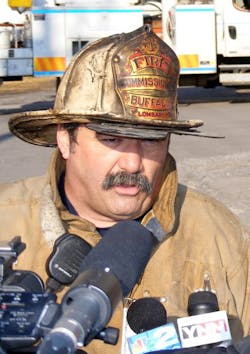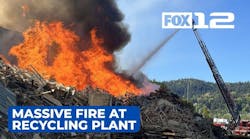In my last article (Firehouse®, March), I discussed the importance of setting a plan for accurate and clear communications during emergencies. The article covered technology and dispatch protocols, plus the means to identify fire buildings and their exposures. This article will focus on fireground communications from arrival and status reports, plus Maydays.
Communicating on the fireground
Let’s talk about our actual communications as we arrive. I always liked to report my arrival with the address: “Engine 17 is at 102 South James.” This way, the dispatcher can correct me if it was actually North James or 1022. Give a simple, clear and short report.
I used a report that pretty much mirrored my initial size-up as a company officer. The size-up I used was BELOW (building, extent and location of fire, life occupancy and water). Consequently, my report on arrival would be “Engine 17 at 102 South James, 2½-story frame, 25-by-60, occupied dwelling fire on the first floor rear extending to the second, stretching a 1¾-inch hoseline, we have a hydrant.” This doesn’t take long and gives other responding units a good picture.
Some variables would be to not give building dimensions if your common buildings are standard sizes that crews are familiar with. In many departments, the company officer will go into a fast-attack mode retaining command, yet still accompany the hoseline into the building, or will pass command to a later-arriving unit or chief officer. In much of America, it is difficult and dangerous for a company officer to stay outside if there is only a three- or four-person crew assigned to that first-arriving engine. Be accurate as well as honest; it isn’t always easy to do.
Locator phrase
Providing interior reports to command is an important part of an officer’s job. Before we get to our little white lies, I will touch on one other procedure that is helpful on the fireground: the use of a locator phrase. For maybe 10 years, we pushed in the Buffalo Fire Department for members to provide a locator phrase each time they talk on the radio. We did not change the crew's identity; Engine 5 was still Engine 5 and Rescue 1 was still Rescue 1. What we did request, and it did not occur overnight, was that crews gave their identity and location, such as “Truck 11, third floor to command” or “Engine 22, basement to command.” This locator phrase provided a great amount of accountability.
An engine company may be assigned the task of taking a line to the third floor to attack a fire. With a locator phrase, it will help the incident commander keep track of resources and assignments and will provide further clarity if the assignment changes. In the following, “Engine 6, second floor to command,” the incident commander now knows that the engine has not arrived at the assigned location. The biggest benefit to a locator phrase is that if all goes bad, at least the last time we had communication with units, we knew where they were. In a major collapse or other catastrophic event, this information can be critical.
Honesty and accuracy
As I said, being honest and accurate are not always easy. Saying that the “primary is clear on the fire floor,” but you haven’t made the fire room yet, is not accurate. If you discover two dead kids in that room after giving a “clear” report, many chiefs might want to have a chat with you after the fire. More than one company officer (guilty) has told the incident commander that “a couple minutes and we got this, Chief” after being ordered out of a fire building, only to be surprised to see two floors of fire upon exiting the building.
Try to anticipate what your report should be. If the chief calls the first-in engine, there does not need to be a long discussion:
“Battalion to Engine 17.”
“Engine 17, first-floor rear to command. Chief, I’ve got two rooms in the rear. We are just getting water on it now.”
As a chief officer, that kind of report made me very happy. I knew that conditions would be improving rapidly, that the engine had located the fire and had the capability to handle the fire in front of them and also our backup line could now be deployed to the upper floor to cut off any potential extension.
So I am getting ahead of myself a bit. Let’s talk about our reports and plain language.
We seem to want to sound very technical and all we do is muddle and confuse. Here is a true example of a radio transmission that I listened to: “Command to operations, verify with fire attack Division 3 their situation status and obtain a CAN report.”
My transmission, if I was the incident commander of that fire, would be: “Engine 17, how are you making out in the attic?” (I thought it was said that we should go away from 10-codes and go to plain language!)
We should not replace codes with a language that is a new code. Just talk; it is OK to not have all the terms and phrases down. Just communicate your message and make sure you listen for messages yourself. More than once when things were very serious as an incident commander, I would call a company and use an officer’s name. I know that is blasphemy to many, but it is amazing how well it gets peoples’ attention: “Kevin, back down from the attic.” It’s amazing how well you will hear and probably pay attention to that statement when it is attached to your name.
Another example of clear communication is face-to-face communication on the fireground. It certainly isn’t something that you have to do constantly, but there are situations that lend themselves to face-to-face messages. Sometimes, it is as simple as relaying a task that is a bit complicated and you don’t want to tie up the radio, such as telling a truck company where you need some opening up done in a specific section of the building. Another is relaying a message regarding a very dangerous situation and you want to make sure that the message is clearly understood. These can all be done on the radio, of course, and many times you have no choice, but to put your hand on a shoulder and have some eye contact can impart much more than a simple radio transmission can.
Passing command is also a time when face-to-face communication is helpful. An extensive amount of information needs to go from one commander who is giving command to another either higher level or when being relieved. Here is an example of the information to be passed from chief to chief at a fire.
• Location and extent of fire
• Operational mode
• Objectives
• Actions – hoselines, number and location
• Primary search status
• Accountability- where are they operating
• Available units
• Hazards concerns
Emergency messages
The last item that we will discuss is emergency traffic. This could easily be an article or a book by itself. I want to preface this by saying that I have had the very sad experience of being at fires where 10 firefighters have been killed, five in one incident and two in another and three single-fatality incidents. Calling a Mayday and reacting to a Mayday is a tough situation for all involved.
In my opinion, this is an area that, as a fire service, we have gotten better at. When I started in the fire service 38 years ago, you wouldn’t think of calling a Mayday for yourself: “I can find my way out of this basement. I’ve made four laps but I will figure it out” seemed to be the common theme at the time. Today, we do a pretty good job of teaching young firefighters to call for help. We never want to be good at this, but obviously we do need to train to be proficient God forbid it happens to us.
One facet of emergency traffic operations that seems to spark debate is whether to move operations to different channels during a Mayday event. In Buffalo during a Mayday, one of our division chiefs who was incident commander ordered the Mayday to remain on the current channel along with the battalion chief as well as two engines the firefighter assist and search team (FAST) truck and the rescue and all other units operating were to go to a different channel. This worked very well; however, I have heard dissenting arguments of all units staying on the original operating channel. This is something that departments should discuss decide on and train for.
There are multiple mnemonics out there for use in Mayday situations. I have taught and used some of these, but after being on scene and involved in 10 line-of-duty deaths, I find simpler is better. One mnemonic – LUNAR – has been around for quite a while:
• L – Last known location
• U – Unit
• N – Name
• A – Assignment
• R – Radio equipped
This mnemonic was initially used to alert the incident commander that a member was missing. Besides the ability to contact the missing member, the radio was to employ feedback-assisted rescue. This was when radios were turned off and two radios were put together and keyed to produce feedback in hopes of hearing and locating the downed missing firefighter. This was before the days of personal alert safety system (PASS) alarms, obviously. Today, some have changed the R to “Resources needed” and others have changed the R to “Remaining air.”
A newer mnemonic that is being taught is GRAB LIVES:
• G – Gauge – air remaining
• R – Radio – equipped
• A – Activate – PASS
• B – Breathe – control breathing
• L – Low – stay low
• I – Illuminate – use a light to mark your location
• V – Volume – make noise
• E – Exit – search for an exit
• S – Shield – shield yourself if out of air
I guess these are fine to teach folks, but in a true emergency, I really don’t think they work. If you are trained well in LUNAR and all of your firefighters are, and you all have worked on this until it is muscle memory, that is great. But if not and if you, your friend or someone you are responsible for is burning to death, all of these mnemonics are most likely nonsense. If in that moment of sheer terror all else fails, try to remember simply: who, what and where:
• Who – is in trouble or missing
• What – is wrong
• Where – you are think you are or the last place you saw them
Summary
This article has discussed a wide range of material as it relates to fire-ground communications. Try to stick to true plain language and just talk and listen. And, from firefighters to bosses, demand that our equipment works and works for us!
An expanded version of this article with graphics is available at: firehouse.com/12049299.
MIKE LOMBARDO is a 38-year veteran of the fire service and was the commissioner/chief of department of the Buffalo, NY, Fire Department from January 2006 to January 2010. He is a New York State fire instructor and was a member of the development team for the New York State Firefighter Survival and Rapid Intervention programs. He is a two-time Firehouse® Magazine Heroism Award recipient (1988 and 1994). Lombardo is a faculty member of the Fire Department Training Institute at Harrison College and the Fire Department Training Network where he presents and developed the Fire Command program. He currently operates with the Christiana and Rehoboth Beach fire departments in Delaware. He is a consultant and instructor on fire tactics, live fire attack, firefighter survival and command and fire department operations throughout the United States.






